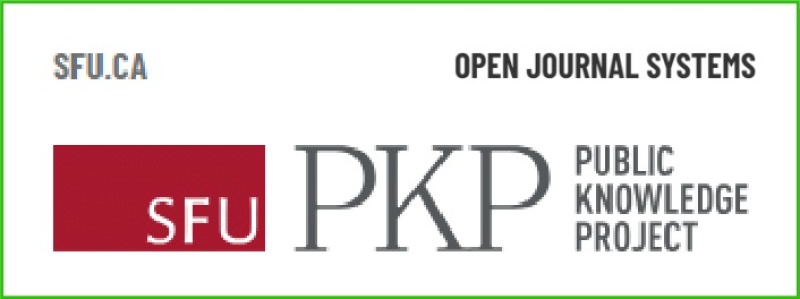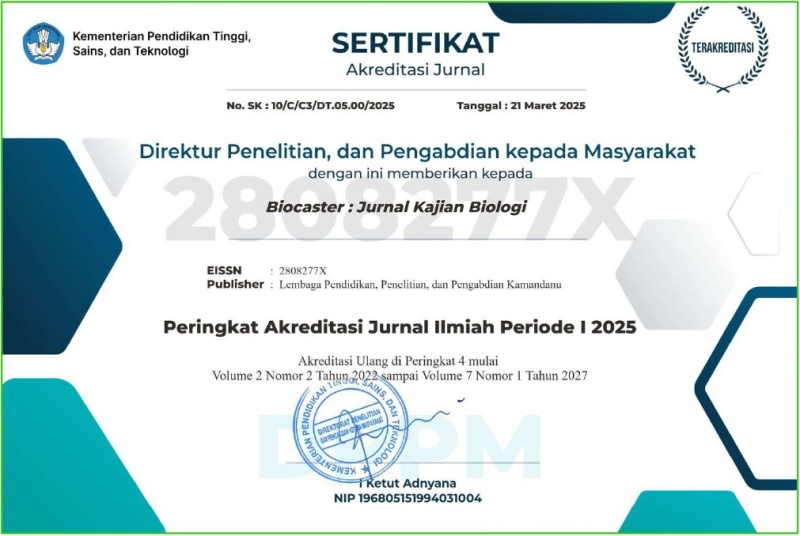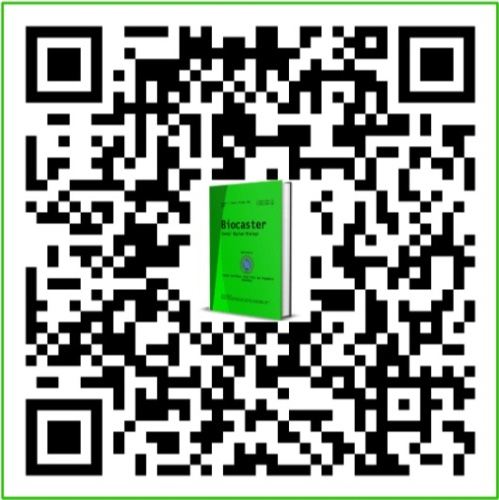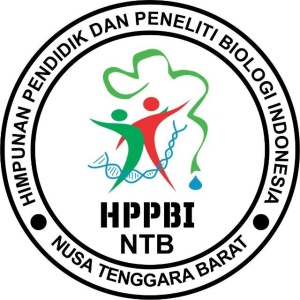Deteksi dan Identifikasi Telur Cacing Nematoda pada Feses Sapi Bali (Bos sondaicus) di Desa Mumbul Sari Kecamatan Bayan Kabupaten Lombok Utara
DOI:
https://doi.org/10.36312/biocaster.v5i4.643Keywords:
Worm Infection, Balinese Cow, Nematode EggsAbstract
Indonesia is a country rich in natural resources, including in the field of livestock, one of which is cattle. Cows have an important role as providers of meat needs for the community. However, cows are also at risk of being infected with worms that can reduce immunity, inhibit weight gain, and potentially cause death. The purpose of this study is to detect and identify nematode worm eggs in the feces of Balinese cows (Bos sondaicus) located in Mumbul Sari Village, North Lombok Regency. The sampling method in this study uses the purposive sampling method based on the maintenance system. Sampling of Balinese cow feces (Bos sondaicus) was taken in Mumbul Sari Village, North Lombok Regency, by taking fresh cow feces, then taken to the Parasitology Laboratory, Faculty of Veterinary Medicine, Mandalika Education University, to be examined using the saturated sugar flotation method, then observed under a microscope with a magnification of 100 times. The results of the study showed positive examination, namely the presence of Trichostrongylus sp; Toxocara vitulorum sp; Oesophagostomum sp; and Haemonchus contortus sp; on the feces of Balinese cattle from Mumbul Sari Hamlet, Bagek Nunggal, Pawang Kunyit I, Pawang Kunyit II, and Munder Hamlet.
Downloads
References
Adekantari, Y. E., Supriadi, S., & Ningtyas, I. S. N. (2023). Prevalensi Nematoda Gastro Intestinal pada Ternak Sapi di Dusun Gili Meno Desa Gili Indah Kecamatan Pemenang. Jurnal Ilmiah Sangkareang Mataram, 10(2), 7-11.
Asrulla, A., Risnita, R., Jailani, M. S., & Jeka, F. (2023). Populasi dan Sampling (Kuantitatif), serta Pemilihan Informan Kunci (Kualitatif) dalam Pendekatan Praktis. Jurnal Pendidikan Tambusai, 7(3), 26320-26332. https://doi.org/10.31004/jptam.v7i3.10836
Bulkaini, B., Ariana, T., Yulianto, W., Mastur, M., & Dahlanudin, D. (2022). Kinerja Produksi Sapi Bali dengan Pemberian Pakan Kulit Nanas Feremtasi. In Prosiding SAINTEK LPPM Universitas Mataram (pp. 191-196). Mataram, Indonesia: Lembaga Penelitian dan Pengabdian kepada Masyarakat, Universitas Mataram.
Frans, H. J. C., Datta, F. U., & Simarmata, Y. T. R. M. R. (2020). Deskripsi Parameter Fisiologis Normal Ternak Sapi Bali (Bos sondaicus) di Desa Pukdale Kecamatan Kupang Timur Kabupaten Kupang. Jurnal Veteriner Nusantara, 3(2), 120-129. https://doi.org/10.35508/jvn.v3i2.3416
Katiandagho, D., Fauziah, S. N., Suwarja, S., Hermansyah, H., Lalangpuling, I. E., Sitompul, A. J., Nuraeni, M., Lukiyono, Y. T., Yamistada, G., Ihtiaringtyas, S., Sari, O. P., Sulistyawati, D., Latumanuwy, L., & Meliala, A. (2025). Parasitologi. Cilacap: PT. Media Pustaka Indo.
Martin, S. W., Meek A, H., & Willeberg, P. (1987). Veterinary Epidemiolgy: Principles and Methods. Iowa: Iowa State University Press.
Muktar, Y., Belina, D., Alemu, M., Shiferaw, S., & Belay, H. (2015). Prevalence of Gastrointestinal Nematode of Cattle in Selected Kebeles of Dire Dawa Districts Eastern Ethiopia. Advances in Biological Research, 9(6), 418-423. https://doi.org/10.5829/idosi.abr.2015.9.6.96213
Purwatihningsing, P., Susanto, E., & Qomaruddin, M. (2016). Perbandingan Prevalensi dan Infeksi Parasit Nematoda pada Sapi Potong Antara Model Kandang Berlantai Beton dengan Berlantai Tanah di Kecamatan Palang Kabupaten Tuban Tahun 2016. Jurnal Ternak, 7(2), 1-10. https://doi.org/10.30736/.v7i2.9
Puspitasari, A., Setiawan, B., Koesdarto, S., Kusnoto, K., Soeharsono, S., & Hastutiek, P. (2019). The Distribution of Goat Gastrointestinal Tractus Worm Egg at Rambon District of Nganjuk Regency. Journal of Parasite Science, 3(2), 59-66. https://doi.org/10.20473/jops.v3i2.16519
Sajuri, I. A. S., Dwinata, I. M., & Oka, I. B. M. (2017). Prevalensi Infeksi Cacing Nematoda Saluran Pencernaan pada Sapi Bali di Tempat Pembuangan Akhir (TPA) Suwung Denpasar. Indonesia Medicus Veterinus, 6(1), 78-85. https://doi.org/10.19087/imv.2017.6.1.78
Supriadi, S., Kutbi, M. K., & Nurmayani, S. (2020). Identifikasi Parasit Cacing Nematoda Gastrointestinal pada Sapi Bali (Bos sondaicus) di Desa Taman Ayu Kabupaten Lombok Barat. Bioscientist : Jurnal Ilmiah Biologi, 8(1), 58-66. https://doi.org/10.33394/bioscientist.v8i1.2658
Taylor, M. A., Coop, R. L., & Wall, R. L. (2015). Veterinary Parasitology, 4th Ed. London: Blackwell Publishing.
Velde, F. V., Charlier, J., & Claerebout, E. (2018). Farmer Behavior and Gastrointestinal Nematodes in Ruminant Livestock-Uptake of Sustainable Control Approaches. Frontiers in Veterinary Science, 16(5), 1-12. https://doi.org/10.3389/fvets.2018.00255
Wibisono, W. (2010). Atlas Spermatologi. Bandung: PT. Refika Aditama.
Downloads
Published
How to Cite
Issue
Section
License
Copyright (c) 2025 Khaerul Mujmal, Iwan Doddy Dharmawibawa, Kholik, & Maratun Janah

This work is licensed under a Creative Commons Attribution-ShareAlike 4.0 International License.
-
Attribution — You must give appropriate credit, provide a link to the license, and indicate if changes were made. You may do so in any reasonable manner, but not in any way that suggests the licensor endorses you or your use.
-
ShareAlike — If you remix, transform, or build upon the material, you must distribute your contributions under the same license as the original.











































